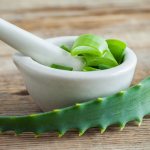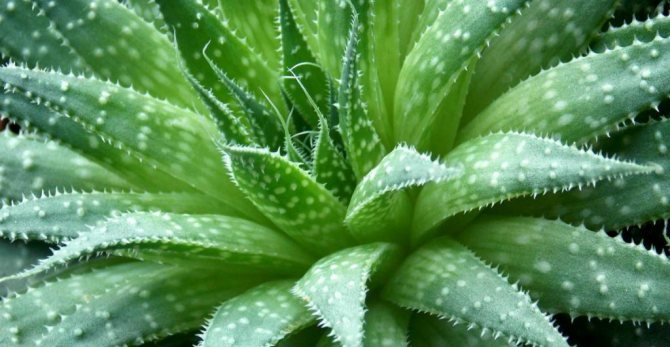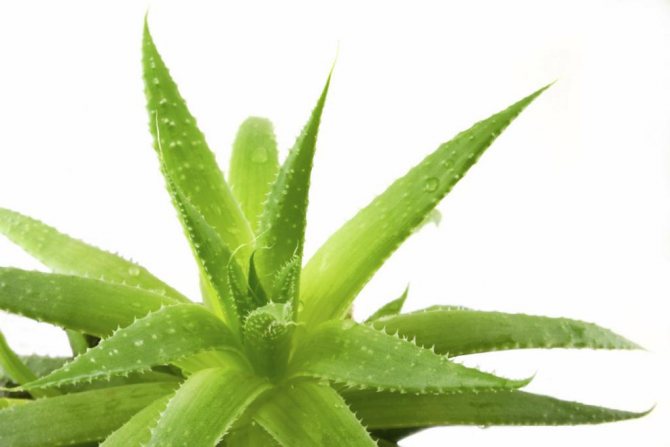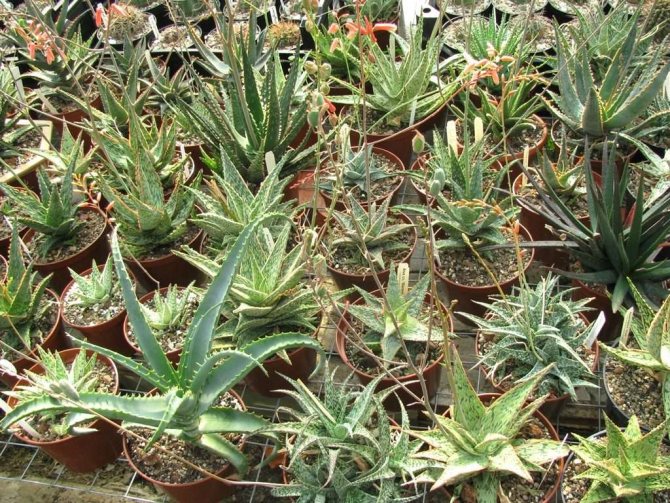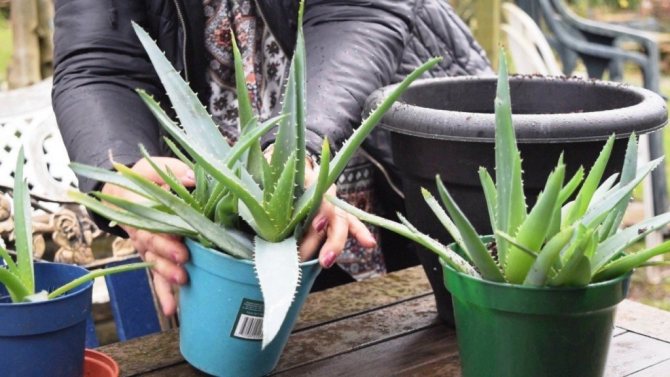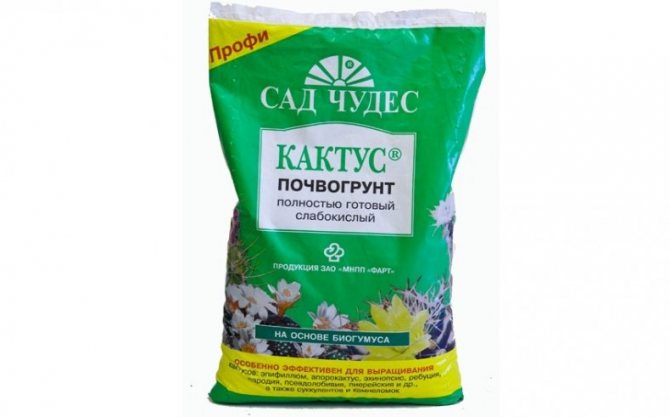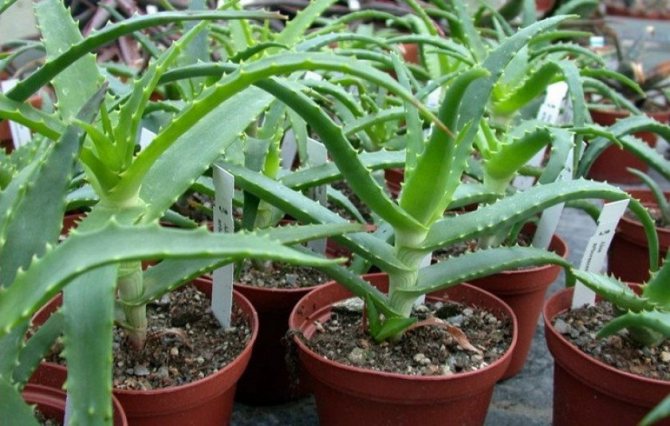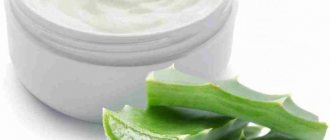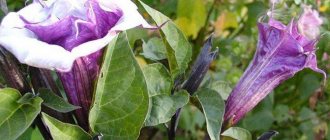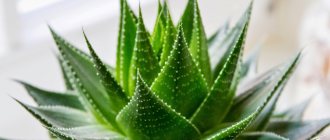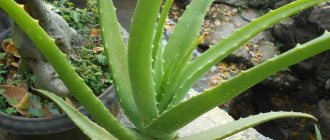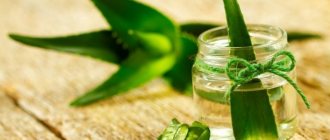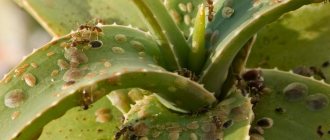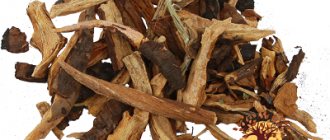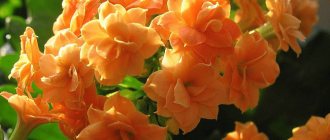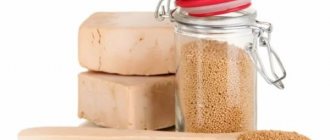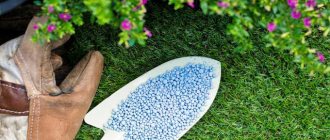Aloe is the same "grandmother's flower" that each of us knows from childhood. Indeed, there are few families where this home doctor-agave would not be grown (this is also the name of this plant). Sometimes growing to an impressive size, it often shades the window and gives trouble to owners who do not know what to do with it. But you can and should use it! Those valuable qualities that aloe possesses are not inherent in any other indoor plant. What types of aloe can be used for medicinal purposes, and how best to do it, we will tell you in this article.
Aloe - medicinal types and effective recipes
Medicinal types of aloe
The genus of aloe is numerous xerophytes and succulents. Perennial plants in nature are found in the form of herbaceous leafy, shrub and even tree-like forms. There are a lot of varieties of aloe, but they all come from the tropics of southern Africa, Madagascar and the Arabian Peninsula.
The main feature of aloe is its thick, xiphoid leaves. It is in them that the plant accumulates moisture, which allows it to survive drought and other disasters of nature. In difficult weather conditions, aloe closes the pores of the skin, due to which the water accumulated in the leaves remains for quite a long time, without evaporating or drying out the plant.
Various types of aloe can be found on sale, but many of them are decorative flower forms. Only two types have healing qualities - Aloe Vera and Aloe tree.
Aloe vera
Aloe vera (Aloe vera
) - one of the types of plant, which would be more correct to call
aloe... But both names are used equally.
Aloe is a short-stemmed succulent plant. Thick, fleshy leaves form a dense rosette, which naturally grows up to 60 cm in diameter. Aloe vera leaves are gray with small spots on the surface. The edges of the leaf plate are covered with small thorns. The root system is poorly developed. Aloe vera flowers are tubular, of different shades of orange, but you can see them only in natural conditions - your "doctor" will not want to bloom on the windowsill.
Aloe tree
Aloe tree (Aloe arborescens
) can look like a tree or shrub and in nature often reaches five meters in height. The trunk is covered with long fleshy leaves with soft thorns along the edges. In an adult plant, the lower leaves fall off, and the bare trunk is covered by numerous basal offspring, making the aloe look like a spreading bush.
During the flowering of the aloe, a long panicle appears with bright orange flowers. When kept at home, it rarely blooms, and the size of a houseplant is much more modest.
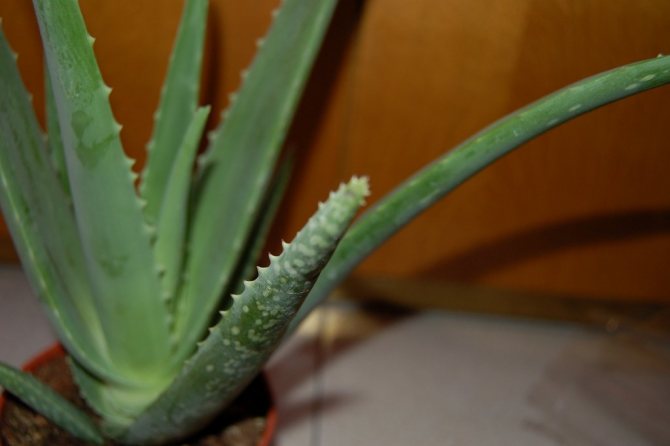
Aloe vera
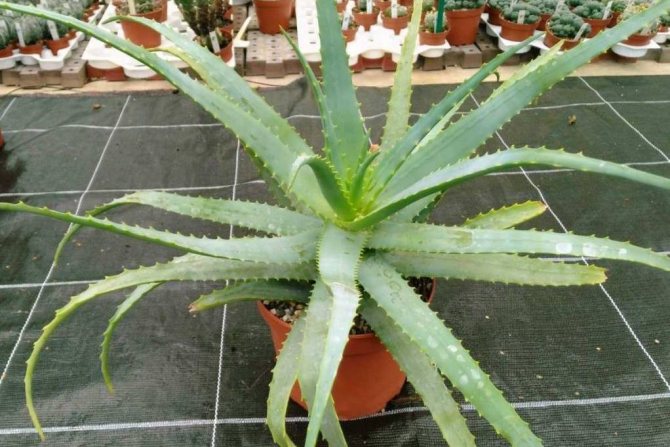

Aloe arborescens (Aloe arborescens).
Reproduction of indoor aloe
This is one of the easiest crops to breed. Indoor aloe is easier to propagate by separating daughter offspring during transplantation (you can only separate daughter sockets that have formed their own roots) or by cuttings.
In this culture, both apical and leafy cuttings can be used. Rooting is carried out under a hood in a light sandy substrate, maintaining light soil moisture and providing long daylight hours with additional lighting. It is advisable to dry the slices before planting.
Growing from seeds at home is rarely used. They are sown in shallow containers, in a sterile sandy substrate, superficially, under a film or glass. Young plants are very afraid of waterlogging and any contacts - they are carefully dived only after the second leaf appears.
The healing properties of aloe
Aloe is a unique medicinal plant. Its chemical composition is unique - the plant sap contains about two hundred and fifty active biological substances. Aloe leaves are 97% water - the very juice that is a concentrate of nutrients.
Aloe juice contains:
- vitamins A, C, E and B vitamins;
- trace elements - zinc, manganese, phosphorus, calcium, selenium, potassium, iron, etc .;
- various essential oils, including esters;
- phytoncides and flavonoids;
- tanning agents and resins;
- amino acids;
- beta carotene;
- alkaloids and other useful substances.
In terms of the content of nutrients, the juices of tree-like aloe and aloe vera are approximately the same, but it is believed that the former is more successful in treating skin diseases, and the latter - diseases of the internal organs.
Aloe is a very unassuming plant and everyone can grow it, if there is a desire. This plant can grow in a cramped pot for years and withstand neglect from its owners. But in order for the medicinal properties of aloe to be at the level, the plant must be provided with nutritious soil and timely feeding.
Photo
Below is attached a photo of flowers, in which you can see how the Aloe Vera flower differs from the usual agave or Aloe tree.
Photo of Aloe Vera:
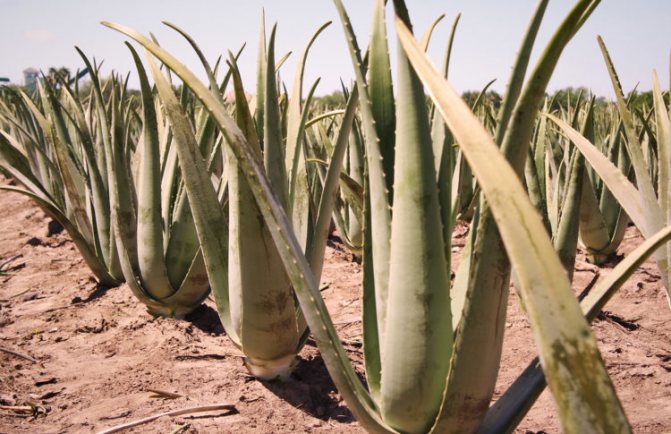

Photo of Aloe treelike:
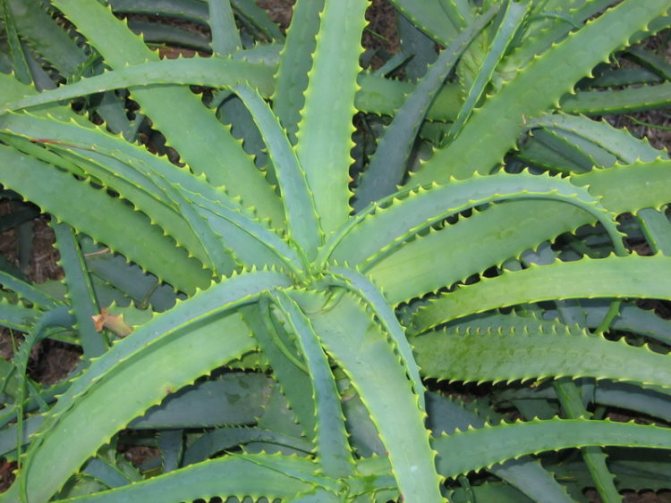

The use of aloe in medicine
Aloe juice has been used for a long time to treat all kinds of ailments. The doctors of antiquity and the priests of ancient Egypt prepared their medicines with the addition of the juice of this plant and relieved their patients from many diseases. Modern medicine confirms the healing properties of aloe and uses it to create various medicines.
Traditional healers use aloe juice in its pure form or with the addition of medical alcohol, as well as plant leaves, extract and sabur (one stripped off juice). The age of the plant is of great importance - it must be at least 3 years old. The older the aloe, the more nutrients its leaves contain.
Due to its bactericidal properties, aloe juice is used for streptococcal and staphylococcal infections. The plant's ability to accelerate tissue regeneration is used in the treatment of purulent and infected wounds and cuts, various inflammatory diseases and radiation. The components of the juice are active against diphtheria and dysentery sticks.
Scientists have isolated an antibiotic from aloe juice, which is used in the treatment of skin diseases and tuberculosis. Ophthalmologists use drops with the addition of aloe juice in the treatment of conjunctivitis, myopia, vitreous opacity and for the prevention of cataracts.
Aloe has an effect on headaches, blood diseases, bronchial asthma and various neuroses. In the treatment of diseases of the stomach and intestines, preparations from this medicinal plant are also used. In low doses, juice has a beneficial effect on digestion, improves bile secretion, strengthens the intestines and has a general strengthening effect on the human body.
Diseases and pests
With an excess of moisture, such troubles arise as root and dry rot.
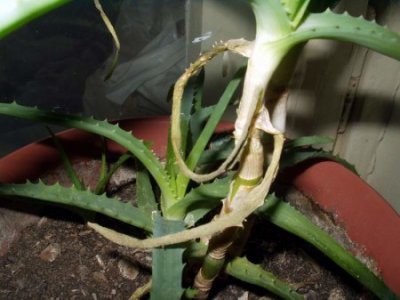

Root rot accompanied by a sudden inhibition of the growth of aloe and its gradual drying out. When these obvious signs occur, the only way to confirm the disease is digging up to examine the roots.
If rot on the roots is found, then you need to carefully cut off the spoiled roots, treat the untouched healthy parts and cuts with coal, and then transplant into new soil with a lot of coarse sand.
After transplanting, do not water the plant for three weeks.
Dry rot insidious lack of external signs. The plant dries from the inside. There are no remedies for this ailment.
Pests infect the agave in case of violation of the rules of care or infection from other plants. The shrub is affected by thrips, scale insects, mealybugs and spider mites. These small insects suck the juices out of the aloe.
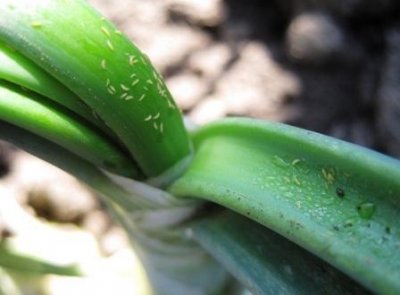

When affected by thrips, scale insects and mealybugs, it is necessary rinse the plant with a sponge and soapy water. In the initial stage of the disease, this will get rid of insidious insects. If insects have spread on a large scale, then the forced method - use of chemicals. The plant is sprayed with insecticides, and a week later, a control procedure is carried out to get rid of the remaining insects and their larvae.
In the case of spider mite infections, completely different drugs are used - special anti-mite.
Rules for the preparation of aloe juice
When preparing aloe juice, you need to adhere to certain rules:
- two weeks before the leaves are removed, the plant is no longer watered;
- the leaves are not cut, but carefully separated from the stem by hands - this will prevent the juice from flowing out;
- to obtain juice, the leaves are removed from the lower and middle parts of the trunk, that is, the oldest;
- the collected leaves are put in a plastic bag and put into the refrigerator for 7-10 days (in this way the plant accumulates the maximum amount of bioactive substances);
- aged leaves are washed with water and dried;
- juice can be squeezed out by hand, after crushing the raw material with a knife or using a meat grinder, juicer or blender.
From interaction with metal in aloe juice, vitamin C is partially destroyed. To prevent this from happening, it is better to grind the leaves with a ceramic knife, and squeeze the juice through a gauze napkin folded in two layers.
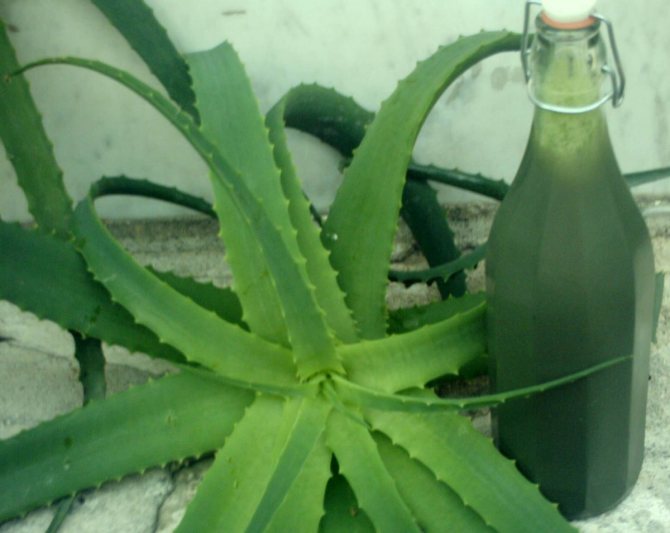

Aloe juice can be squeezed by hand or using a meat grinder, juicer, or blender.
Planting and caring for aloe
- Bloom: the plant is grown as an ornamental-deciduous and medicinal plant.
- Lighting: bright sunlight. In winter, aloe vera may require additional lighting.
- Temperature: in spring and summer - usual for residential premises, in winter - no higher than 14 ºC.
- Watering: during the period of active growth - as soon as the top layer of the substrate dries. In winter - two days after the top layer has dried. When moistened, water should not get into the outlet of the leaves.
- Air humidity: common for living quarters.
- Top dressing: once a month with mineral fertilizers during the growing season - from mid-spring to early autumn.
- Rest period: from mid-autumn to mid-spring.
- Transfer: at the beginning of the growing season: young plants - once every two years, adults - once every four years.
- Substrate: two parts of sod land and one part each of sand and leafy land.
- Reproduction: seeds and root shoots.
- Pests: aphids, scale insects, mealybugs and spider mites.
- Diseases: all aloe problems are from improper care. In particular, over-watering the plant can rot.
- Properties: some types of aloe have healing properties: wound healing, anti-inflammatory, bactericidal, immunostimulating, regenerating and others.
Read more about growing aloe below.
Folk recipes based on aloe
Vitamin Bomb
Aloe juice is mixed with Cahors or any quality red wine and honey in equal amounts. The mixture is removed in a dark cool place and insisted for at least 5 days. Take before meals 1 tablespoon three times a day. An excellent remedy for cleaning blood vessels and increasing immunity.
For the treatment of herpes
Lubricating the ulcers with aloe juice (5-6 times a day) prevents the spread of rashes, dries out and accelerates recovery.
Laxative
Aloe juice is mixed with warmed honey in a ½ ratio and infused for 24 hours. Drink 1 tbsp. spoon one hour before meals.
For inflammation of the mouth and throat
In these cases, rinses are used. To do this, dilute aloe juice with warm boiled water in a ratio of 1/1.
For toothache
A piece of aloe leaf with a cut part is placed on a sore tooth - this will help relieve pain before the dentist's help.
With a runny nose
Every day, 2-3 drops of aloe juice are instilled into each nostril. For children, the juice is diluted in half with water.
After a serious illness
To restore strength after a serious illness, half a glass of aloe juice is mixed with 300 g of chopped walnuts, 300 g of honey and juice of 3 lemons. Take 1 dessert spoon 3 times daily before meals. The product is suitable for both adults and children.
For the treatment of tuberculosis
Prepare a mixture: grind half a pack of butter with 20 g of aloe juice, add half a glass of honey and 3 tbsp. l. cocoa powder. They mix everything well and drink 1 tablespoon 3 times a day. It is advised to drink the mixture with hot milk.
For colds and bronchopulmonary diseases
A mixture is used: 300 g of aloe juice, 100 g of medical alcohol and 700 g of dry red wine. Store the product in a cool place without access to light. Drink for adults 1 tbsp. spoon 3 times a day half an hour before meals, children over 5 years of age - 1 teaspoon.
For the treatment of frostbite and burns
A compress with aloe leaves crushed to the state of gruel is applied to the frostbitten areas of the skin and wound surfaces. The same is done for burns.
For smoothing wrinkles
Rub the face with ice and aloe. To do this, plant juice is diluted in half with water, poured into molds and frozen. In the morning, wipe cleansed skin with a piece of ice. This product is good for narrowing pores and increasing blood circulation, therefore it is used not only to reduce wrinkles, but also against acne.
Mask for the face
If the skin is dry, the juice is mixed with any oily cream or olive oil (1/1), for oily skin, take 4 parts of the juice and mix with 1 part of alcohol. A gauze mask is impregnated with the mixture and applied to the face for 15-20 minutes. To enhance the effect, add a little honey to the mixture.
For hair growth
1 tbsp. l of aloe juice mixed with 50 ml of apple cider vinegar, 1 tsp of burdock oil and juice of 1 lemon. Massage the mixture into the scalp and apply to the hair. Put a shower cap on your head and wrap it with a terry towel to keep warm. Leave for 40 minutes and then rinse with warm water and shampoo.
To strengthen hair
3 tbsp. l of aloe juice mix with 1 raw yolk, add 1 tbsp. l. honey. Put the container with the mixture in a bowl with hot water and mix well. Apply a warm mask to the hair and rub into the skin, wrap and hold for 40 minutes.
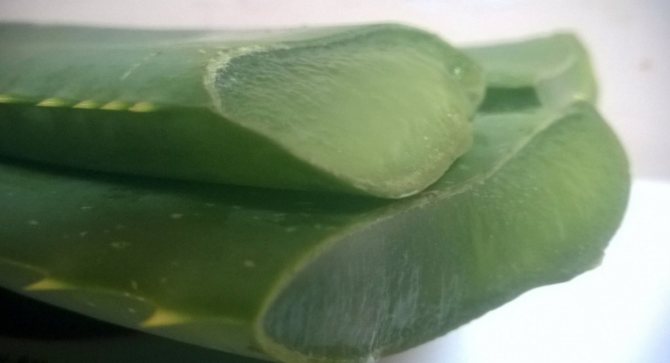

In terms of the content of nutrients, the juices of tree-like aloe and aloe vera are approximately the same.
Growing aloe tree
A large perennial tree plant that grows in a tropical climate, it follows that the temperature for its normal development should be above + 25 degrees. Aloe tree does not require high humidity, and it will feel calm in the room, on the windowsill, even next to heating devices.
What aloe really does not tolerate is frost and waterlogging. Therefore, in warm latitudes, aloe tree-like can be grown in personal plots.
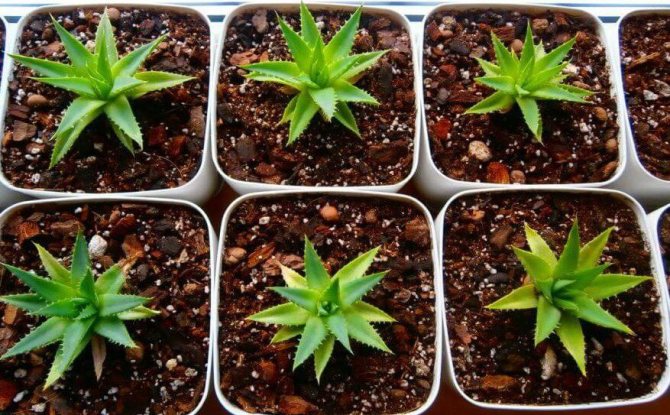

Aloe is a light-loving, heat-loving plant that must be protected in the open field from temperature extremes.
Outdoor aloe, over time, can tolerate a temperature drop of up to +2 degrees. However, one should not assume that the plant is able to survive the winter; in the cold season, a tree-like aloe bush is dug up and moved to a covered room with a temperature suitable for its existence.
The aloe bush, like other cultivated plants, prefers nutritious substrates and needs additional feeding.With proper care, indoor aloe produces 8-10 shoots every year, which can subsequently become seedlings. Growing aloe does not require large areas or grueling maintenance measures.
The pre-prepared substrate (mixed turf soil with sand 2: 1) is poured into small pots or any other container with drainage holes. Places of cuts of side shoots of aloe are pre-dried, and then planted in prepared pots with a substrate to a depth of about 5 cm.
It will not be superfluous to place an additional layer of sand or fine gravel under the planting soil, for better drainage of excess moisture. After planting, the "kids" are placed in greenhouses or placed on windowsills on the sunny side.
After planting, for better rooting, the top layer of the soil is kept moist constantly, for about a month, the optimum temperature during this period is considered to be + 25-27 degrees. After a year, young seedlings can be transplanted into open ground or into a larger pot for further growth and development.
Aloe propagation occurs not only vegetatively, but also by seeds. If during flowering it is possible to collect aloe seeds, then they can also be planted in prepared soil, moistened and warmed daily with the sun's rays, and when the seeds germinate and collect at least three leaves, then they can be transplanted into open ground, in the month of May. In the south, the plant takes root well, and in the northern latitudes, aloe is grown exclusively in greenhouses.
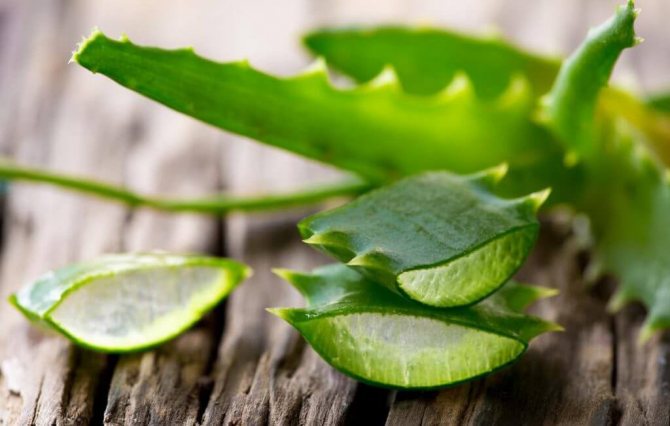

Many growers are faced with the problem of the lack of aloe flowering. To make the plant bloom, it is necessary to change its habitual place of growth and make a "shake", place the flower in a darkened room, with a low temperature, for a couple of weeks, until a peduncle appears.
After that, the flower pot is returned to its usual place and fertilizing is performed with mineral fertilizers. Flowering lasts about two weeks, and after that, a seed box with seeds appears, which can be planted in a new pot in the future.
Contraindications to the use of aloe
Do not use preparations containing aloe juice during pregnancy. Hypertension, heart disease, oncology, various bleeding, as well as any acute gastrointestinal diseases are also contraindications for the treatment of aloe.
Whatever useful properties aloe has, it must be remembered that this is a medicinal plant, and you cannot take it thoughtlessly. It is best to consult your doctor. But, in any case, treatment should be started with small doses in order to avoid such unpleasant manifestations as allergies.
Aloe is one of those gifts of nature that any of us can use without leaving home. The fields of application of this miraculous plant are endless, with skillful handling, aloe juice will benefit not only as a healer and cosmetologist, but, thanks to its amazing composition, will help to increase immunity and strengthen health.

